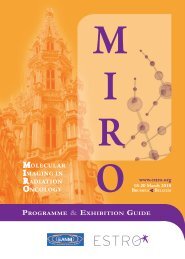World Congress of Brachytherapy 10-12 May, 2012 - Estro-events.org
World Congress of Brachytherapy 10-12 May, 2012 - Estro-events.org
World Congress of Brachytherapy 10-12 May, 2012 - Estro-events.org
You also want an ePaper? Increase the reach of your titles
YUMPU automatically turns print PDFs into web optimized ePapers that Google loves.
1<br />
INTRODUCTION<br />
C.HaieMeder<br />
Institut Gustave Roussy, Radiation Oncology, Villejuif, France<br />
Target volume determination is probably one <strong>of</strong> the most challenging<br />
issues in radiation oncology, at the era <strong>of</strong> highly targeted<br />
radiotherapy. BT has to face this challenge, even in a more accurate<br />
way, as BT physical and biological properties provide the most<br />
conformal and normal tissue sparing radiotherapy technique. To reach<br />
this goal, BT has benefited from recent advanced imaging<br />
technologies. The use <strong>of</strong> 3D techniques for BT dosimetry has increased<br />
during the recent years, mainly CTbased, but also using MRI, PETCT<br />
and ultrasound. Image guidance improves tumor and <strong>org</strong>ans at risk<br />
visualization, and their relationship with the applicator (in<br />
gynecological tumors), representing the basis for 3D and 4D BT<br />
treatments plans.<br />
Prostate BT was developed using ultrasound guidance. The accuracy<br />
<strong>of</strong> seed placement and dosevolume parameters has significantly<br />
improved with more sophisticated imaging modalities. Emerging<br />
techniques in ultrasound and MRI modalities, including functional<br />
imaging, as well as 3D digital mapping, allow for more accurate<br />
disease characterization with improvement in staging and<br />
management <strong>of</strong> the tumor. This issue represents the basis for dose<br />
painting.<br />
In cervical cancer BT, MRI based adaptive BT enables 4D target<br />
volume optimization with appropriate dosevolume constraints for<br />
<strong>org</strong>ans at risk. First clinical series report an improvement in local<br />
control which seems to translate into a survival benefit. Ultrasound is<br />
an evolving field and is currently under study. The value <strong>of</strong> functional<br />
MRI or PETCT is also under investigation.<br />
In endometrial cancer, postoperative BT has become the new<br />
standard in intermediaterisk patients. In this situation, there is a<br />
potential for imagebased individualization which is under<br />
investigation.<br />
Apart from these two main tumor sites, BT using new imaging<br />
modalities has been developed in other fields, such as breast, head<br />
and neck and endoluminal (bronchus, oesophagus).<br />
In the last decade, the use <strong>of</strong> imaging modalities integrated into the<br />
BT procedure has led to a significant increase <strong>of</strong> BT all over the world.<br />
The use <strong>of</strong> images also led to the development <strong>of</strong> BT guidelines,<br />
allowing multiinstitutional studies, contributing to clinical research<br />
and scientific publications.<br />
2<br />
ROLE OF FUNCTIONAL IMAGING<br />
B. Carey 1<br />
1<br />
St James Institute <strong>of</strong> Oncology The Leeds Teaching Hospitals NHS<br />
Trust, Radiology, Leeds, United Kingdom<br />
The evolution <strong>of</strong> the art <strong>of</strong> brachytherapy into a precision form <strong>of</strong><br />
scientifically based radiation therapy owes much to major<br />
developments in imaging and computer technology over the past<br />
decade. <strong>Brachytherapy</strong> <strong>of</strong>fers the most conformal <strong>of</strong> all forms <strong>of</strong><br />
radiotherapy and is designed largely around the intricate relationships<br />
between radiation dose delivered, target volume and fractionation<br />
regimes. Traditional brachytherapy planning techniques have<br />
benefited enormously from morphological imaging techniques such as<br />
Computed Tomography, Magnetic Resonance Imaging and Ultrasound.<br />
Tumour volumetricbased radiation planning based on better anatomy<br />
has much improved our ability to target malignant tissue whilst<br />
sparing nonmalignant tissues. 3D target localisation has been<br />
successfully modelled around a hierarchy <strong>of</strong> expanding treatment<br />
volumes based on the demonstrable tumour morphology as well as<br />
allowing for technical imperfections and variations in treatment<br />
delivery. A new paradigm for treatment planning and radiation<br />
delivery is now becoming possible with the ability <strong>of</strong> medical imaging<br />
<br />
<br />
to define areas <strong>of</strong> varying functional activity within the presumed<br />
tumour mass.<br />
A new probability envelope is emerging based on our recognition <strong>of</strong><br />
the altered biological and molecular processes occurring in tumour<br />
tissue. A biological target volume can be identified generally as a<br />
subset or subsets <strong>of</strong> the morphological target volume and <strong>of</strong>fers a<br />
potentially modified approach for brachytherapy. These new<br />
functional maps <strong>of</strong> the tumour provide the basis for a very innovative<br />
approach to radiation treatment using much more selective planning<br />
and treatment delivery techniques. Locating and quantifying areas <strong>of</strong><br />
cellular and molecular disruptions within the tumour mass <strong>of</strong>fer the<br />
potential to individualise the radiotherapy treatment and the highly<br />
conformal and adaptive nature <strong>of</strong> brachytherapy perhaps stands to<br />
gain most from these new functional imaging techniques.<br />
FDGPET has become an established imaging technique in oncology<br />
and is becoming increasingly integrated into treatment planning<br />
processes for several common tumour sites. Newer isotopes are being<br />
developed to further expand the depth and range <strong>of</strong> our knowledge <strong>of</strong><br />
tumour behaviour and will <strong>of</strong>fer future targets for brachytherapy dose<br />
delivery and modifications. Functional MRI is providing us with<br />
additional physiological surrogate targets for dose modifications.<br />
Newer developments in functional Ultrasound and CT will also<br />
enhance the information available to the radiation oncologist and<br />
yield a much more detailed map <strong>of</strong> tumour architecture and function.<br />
The inherent goal <strong>of</strong> brachytherapy is to safely deliver adequate<br />
radiation to those areas <strong>of</strong> tumour tissue that are considered<br />
necessary based on our current understanding <strong>of</strong> tumour biology and<br />
radiation response. Functional imaging <strong>of</strong>fers us a way forward in<br />
identifying subvolumes <strong>of</strong> tumour that may benefit from different<br />
radiation regimes based on different measurements <strong>of</strong> tumour<br />
response. Furthermore, we have the future potential to noninvasively<br />
assess these treatment responses in terms <strong>of</strong> altered cellular and<br />
molecular processes as well as altered tumour morphology. These are<br />
exciting times for functional imaging based brachytherapy.<br />
3<br />
PET IMAGING IN BRACHYTHERAPY<br />
V. Lowe 1<br />
1 <strong>May</strong>o Clinic, <strong>Brachytherapy</strong>, Rochester, USA<br />
Positron Emission Tomography (PET) is now being widely in the<br />
evaluation <strong>of</strong> many types <strong>of</strong> malignancy. Multiple studies have<br />
demonstrated the utility <strong>of</strong> PET in oncologic imaging in better staging<br />
<strong>of</strong> disease, earlier treatment response assessment and better<br />
characterization <strong>of</strong> recurrent disease over what can be done with<br />
anatomic imaging methods alone. The availability metabolic<br />
substrates other than FDG makes PET imaging attractive in some<br />
tumors that have been otherwise poorly evaluated by FDG. This talk<br />
will discuss the use <strong>of</strong> Choline PET imaging with discussion <strong>of</strong> how it<br />
can be used in conjunction with brachytherapy<br />
While prostate cancer cells have not ubiquitously shown FDG avidity,<br />
increased choline uptake has been a more consistent finding on PET<br />
imaging. Cancer cells have more rapid cell proliferation than normal<br />
cells. New cells require the building blocks for cell membranes.<br />
Choline is a watersoluble essential nutrient grouped with B<br />
complex vitamins—that is vital for a) cell membrane structure and<br />
signaling b) synthesis <strong>of</strong> neurotransmitters and c) general metabolism.<br />
[ 11 C]choline is a synthetic form <strong>of</strong> choline that releases positrons by<br />
beta decay that can be visualized by PET. [ 18 F]choline is another<br />
radionuclide version <strong>of</strong> choline that can also be used in PET imaging.<br />
The increased accumulation <strong>of</strong> these agents by prostate cancer in any<br />
part <strong>of</strong> the body is a reliable way to determine the extent <strong>of</strong> prostate<br />
cancer.<br />
Choline PET can be use in two different treatment time points in<br />
prostate cancer related to brachytherapy. At initial staging,<br />
confirmation <strong>of</strong> localized disease to the prostate bed can be<br />
performed using choline PET. Choline PET provides high accuracy for<br />
the detection <strong>of</strong> distant metastasis. This can aid in treatment<br />
planning. Choline PET may be most useful in the situation <strong>of</strong><br />
definitively treated prostate cancer with the discovery <strong>of</strong> biochemical<br />
recurrence. One <strong>of</strong> the clinical dilemmas <strong>of</strong> biochemical recurrence <strong>of</strong><br />
prostate cancer is the how to decide on an optimal treatment









